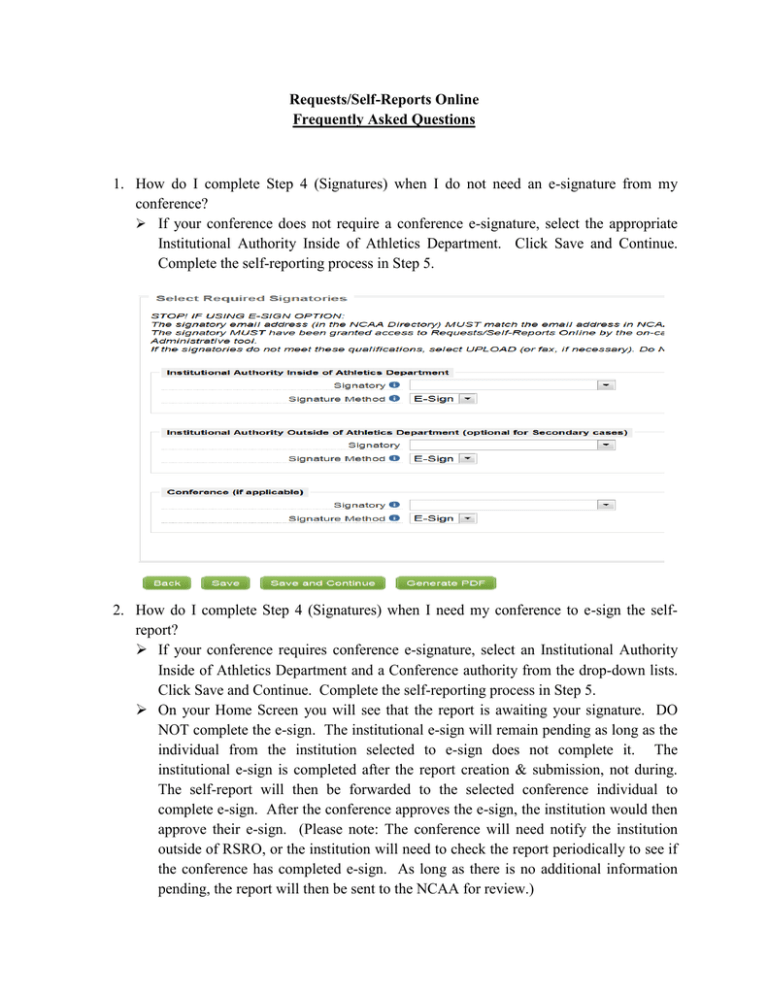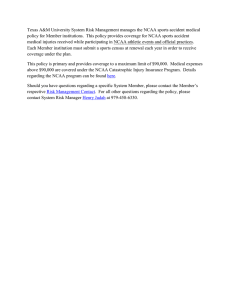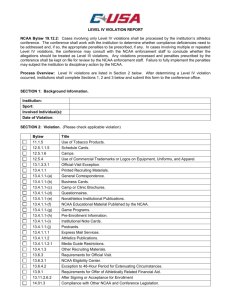Requests/Self-Reports Online Frequently Asked Questions 1.
advertisement

Requests/Self-Reports Online Frequently Asked Questions 1. How do I complete Step 4 (Signatures) when I do not need an e-signature from my conference? If your conference does not require a conference e-signature, select the appropriate Institutional Authority Inside of Athletics Department. Click Save and Continue. Complete the self-reporting process in Step 5. 2. How do I complete Step 4 (Signatures) when I need my conference to e-sign the selfreport? If your conference requires conference e-signature, select an Institutional Authority Inside of Athletics Department and a Conference authority from the drop-down lists. Click Save and Continue. Complete the self-reporting process in Step 5. On your Home Screen you will see that the report is awaiting your signature. DO NOT complete the e-sign. The institutional e-sign will remain pending as long as the individual from the institution selected to e-sign does not complete it. The institutional e-sign is completed after the report creation & submission, not during. The self-report will then be forwarded to the selected conference individual to complete e-sign. After the conference approves the e-sign, the institution would then approve their e-sign. (Please note: The conference will need notify the institution outside of RSRO, or the institution will need to check the report periodically to see if the conference has completed e-sign. As long as there is no additional information pending, the report will then be sent to the NCAA for review.) 3. What do I do if I accidently submit and e-sign a self-report without my conference's esignature, or with inaccurate information? If the report has already been assigned to an NCAA staff member, contact the assigned staff member directly. If the report has not been assigned, contact A. Faith English via email at fenglish@ncaa.org or Kelly Groddy via email at kgroddy@ncaa.org. 4. What do I do if my conference rejects an e-signature? If a conference rejects the e-sign and the institution has not e-signed yet, the report can be un-submitted by the institution. If a conference rejects the e-sign and the institution has e-signed before the conference, the report is no longer pending e-signatures and the report is no longer editable by the institution. In this scenario, the institution would need to contact the NCAA staff member assigned to the report to have the report moved from a "rejected" to an "un-submitted" status. If the report has not been assigned, the institution would need to contact A. Faith English via email at fenglish@ncaa.org, or Kelly Groddy via email at kgroddy@ncaa.org. (Please note: Communication between the institution and conference outside RSRO will be necessary to determine why the conference rejected the e-sign.) 5. How do I make sure the conference is included on e-mails related to the self-report? For the conference to receive e-mails related to the self-report, the institution must list a conference representative as a primary, secondary, or additional contact. 6. How and when can a conference view secondary self-reports filed by member institutions? Conferences can view member institution self-reports while the reports are pending review by the NCAA, and after a decision has been published. The conference can perform a search in the Case Management tab of RSRO on a regular basis to keep track of member institution self-reports. This search will show all secondary cases, including those submitted but not yet processed by the secondary staff. To view published decisions ("precedent"), the conference can use the Search tab of RSRO. The Search functionality allows the conference to search by keywords, sport, bylaw, case type, dates, etc. to narrow a precedent search. 7. Can a conference submit a self-report for an institution? Yes. However, the conference will have to select an Institutional Individual from Inside Athletics to e-sign on Step 4 of the self-report. 8. Can a conference edit or revise a self-report created by an institution in RSRO? No. If a self-report is started and saved by an institution, only authorized individuals at the institution can revise or edit report information within the system. Communication outside the system (e.g. email, telephone, etc.) between an institution and the conference will be necessary to include any conference action or recommended changes to the self-report. 9. How can I ensure that my conference sees my institution's self-reports? The conference will be able to view member institution self-reports as soon as the report has been submitted and is viewable to the NCAA. 10. My Case Management screen has too many columns, can I customize the columns? Yes. There are three ways to "customize" the information on the Case Management screen. Entering specific search criteria, such as institution name, in the Search field will narrow a search to the specified criteria. The user can also customize column headings by clicking Show/Hide Columns and selecting the desired column headers. After running a search, the user can filter the results by clicking the up/down arrows next to the column heading, and selecting the case status from the drop-down list to filter by. (Please note: the filter will continue to run until the user removes the filters by clicking the red circle near the filter criteria.) 11. What do I do if I have questions about the online self-reporting process? Communication should be sent through the Requests/Self-Reports Online System using rsroonline@ncaa.org. Your question will be directed to the appropriate contact who can answer your question. Within the email be sure to indicate whether your report is a Secondary Violation, Student-Athlete Reinstatement, etc. 12. When an institution self imposes a fine and/or the enforcement staff imposes a fine where do I send the money? To ensure proper processing of fine payments, checks, including those for selfimposed fines, should be forwarded to the NCAA after a decision has been communicated to the institution. Checks should be made payable to the NCAA and mailed to P.O. Box 6222, Indianapolis, Indiana 46206 to the attention NCAA Accounts Receivable. If the institution is requesting an invoice, or prefers to pay by credit card, please contact NCAA Accounts Receivable directly at 317-917-6481. 13. When can I expect a decision from my Secondary/Level III Self-Report? The timing of the enforcement staff's decision for an institution's Secondary/Level III violation report is impacted by multiple factors. The enforcement staff continues to be receiving membership feedback regarding RSRO, as well as addressing functionality with the correction of system bugs, providing education and assistance to users during the submission process and moving forward with the development of system enhancements. At the same time, the enforcement staff continues to process self-reports within RSRO as received by the membership. Our goal is to process cases as quickly and efficiently as possible. Our review and the time period between submission and completion are impacted by several factors beyond the use of a new online reporting system. These factors include recognition of the volume and timing of submissions by member institutions as the enforcement staff receives more than 4,000 Secondary/Level III cases annually, with a larger percentage of these self-reports received during the beginning of each academic year. In addition, reaching a decision involves a thorough assessment of the circumstances to ensure the case is appropriately identified as Secondary/Level III and might involve follow up with the institution for clarification of and/or additional information, possible review by other enforcement staff members based on the involved bylaw, sport or ongoing enforcement investigations related to possible Major/Level I or II violations, as well as consideration of the status of any related reinstatement cases. Collectively, these factors as well as others play a role in the timing of a decision. Regardless of the transition to RSRO, as in the past, if an institution needs additional assistance or has questions regarding a self-report, please continue to communicate with a member of the Secondary/Level III enforcement staff. These requests for assistance can be submitted through rsro@ncaa.org or by directly contacting the enforcement staff. 14. What happens if my institution does not accept a decision within the 15 day period? The institutions can no longer appeal the decision after the 15 day period; but, the institution can still accept the decision. If the institution takes no action within the 15 days following the staff's decision, the system will close the case and remove it from the institution's Home Screen. 15. Do I need to distinguish between Level I and Level II self-reports? No. All secondary violations will be processed in the same manner. 16. How do I upload documents, add a legislative cite or interpretation, or fax a signature? Specific instructions on these tasks can be found under the General Instructions section. For your immediate reference, the fax number for the NCAA Enforcement Department (secondary violations) is 317-917-6059. 17. Can I accept my e-signature while I am working on the report? The e-signature is completed after the submission of the report. You do not need to exit RSRO, but will need to access the report by pulling it up again from your Home page and Approve the e-sign. 18. How do I enter multiple student-athletes or entire teams within the self-report? In most cases, we ask that you provide the names of each involved student-athlete in the appropriate section of Step 1 of the report. If a violation involves an entire team and eligibility is not affected, you do not need to include the names of all studentathletes. Bypass the Involved Student-Athlete section and upload a roster or other document with the names of the involved student-athletes under the Case Documentation tab. 19. How do I update the personnel listing in the Signatures section? To add an individual to the institution's contact list, the desired signatory's e-mail address must be registered at NCAA.org, the signatory must have access to RSRO through the Single-Source Sign-On tool, and the institution’s administrator must have setup the individual to appear in the signatory drop-down list. After this has been accomplished, the addition will appear in the Signatory drop down. Remember: the system populates from the membership database, if you encounter problems when requesting an e-sign, please check to make sure that the membership database is updated. 20. Do I need both inside athletics and outside athletics signatures for secondary violation self-reports? No. The only required signature for self-reports is the Institutional Authority Inside Athletics. The Inside Athletics signatory is an individual who works in the institution's athletics department who has been delegated authority to submit secondary violation self-reports on behalf of the institution (e.g., athletics director, associate athletics director, senior woman administrator, or compliance administrator). 21. I have a Reinstatement and a Secondary/Level III self-report, what do I do? Reporting a Secondary/Level III Violation and a Student-Athlete Reinstatement Request in Requests/Self-Reports Online (RSRO) Requires Submission of Two "Related" Cases. When an institution discovers circumstances that impact a prospective or currentlyenrolled student-athlete's eligibility, in most cases the institution must also report a secondary violation (or Level III violation in Division I) in conjunction with seeking reinstatement for an involved individual. Within RSRO, this requires an institution to complete and submit both a reinstatement request and a violation report. We encourage institutions to begin with the student-athlete reinstatement request as this may involve time-sensitive issues. Within Step Two of the Student-Athlete Reinstatement (SAR) request, an institution will be asked if they need to report an NCAA Secondary/Level III violation. In most cases, the institution should answer "Yes" and complete the reinstatement request. Answering "Yes" to this question will prompt RSRO to create the "related" Secondary/Level III violation report. After completing and submitting the SAR request, a message will appear on the institution's screen indicating the SAR request has been successfully submitted and the related Secondary/Level III violation report is available and ready for completion and submission by the institution to the NCAA enforcement staff. This related Secondary/Level III violation report will prepopulate with common responses from the SAR request. The institution should complete any remaining questions as soon as possible. If the institution does not SUBMIT and sign the related Secondary/Level III report, it will remain on the institution's home screen as "saved" or "awaiting signatures" and the enforcement staff will be unable to process the violation. 22. How do I relate a reinstatement request to a self-report? On Step 1 of the self-report, you will be asked if the institution will seek reinstatement of the involved student-athlete(s). Select Yes. If multiple SAR requests will be made, select Yes to the next question. The system will automatically create a related SAR application. You will be routed to the related SAR application after the self-report is successfully submitted. Common information entered in the self-report will carry over to the related SAR application. 23. How do I relate a self-report to a reinstatement request? On Step 2 of the reinstatement application, you will be asked if the institution needs to report a secondary violation. Select Yes. The system will automatically create a related self-report. You will be routed to the related self-report after the SAR submission. Common information entered in the reinstatement request will carry over to the related self-report. 24. What do I do if I have to submit multiple reinstatement requests that involve the same underlying institutional violation? To ensure efficient processing of the secondary violations involving multiple reinstatement requests, it is best to make only one self-report. Ideally, the self-report should be related with the last reinstatement request made through the system. Questions about this process can be directed to contact A. Faith English via email at fenglish@ncaa.org, or Kelly Groddy via email at kgroddy@ncaa.org.

